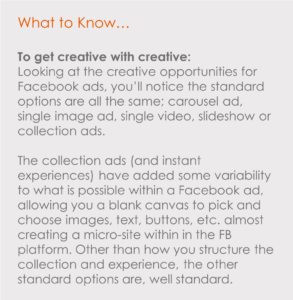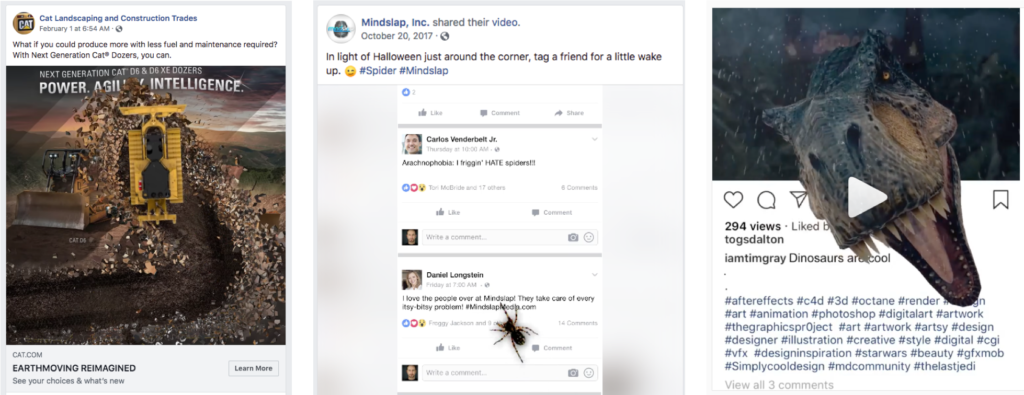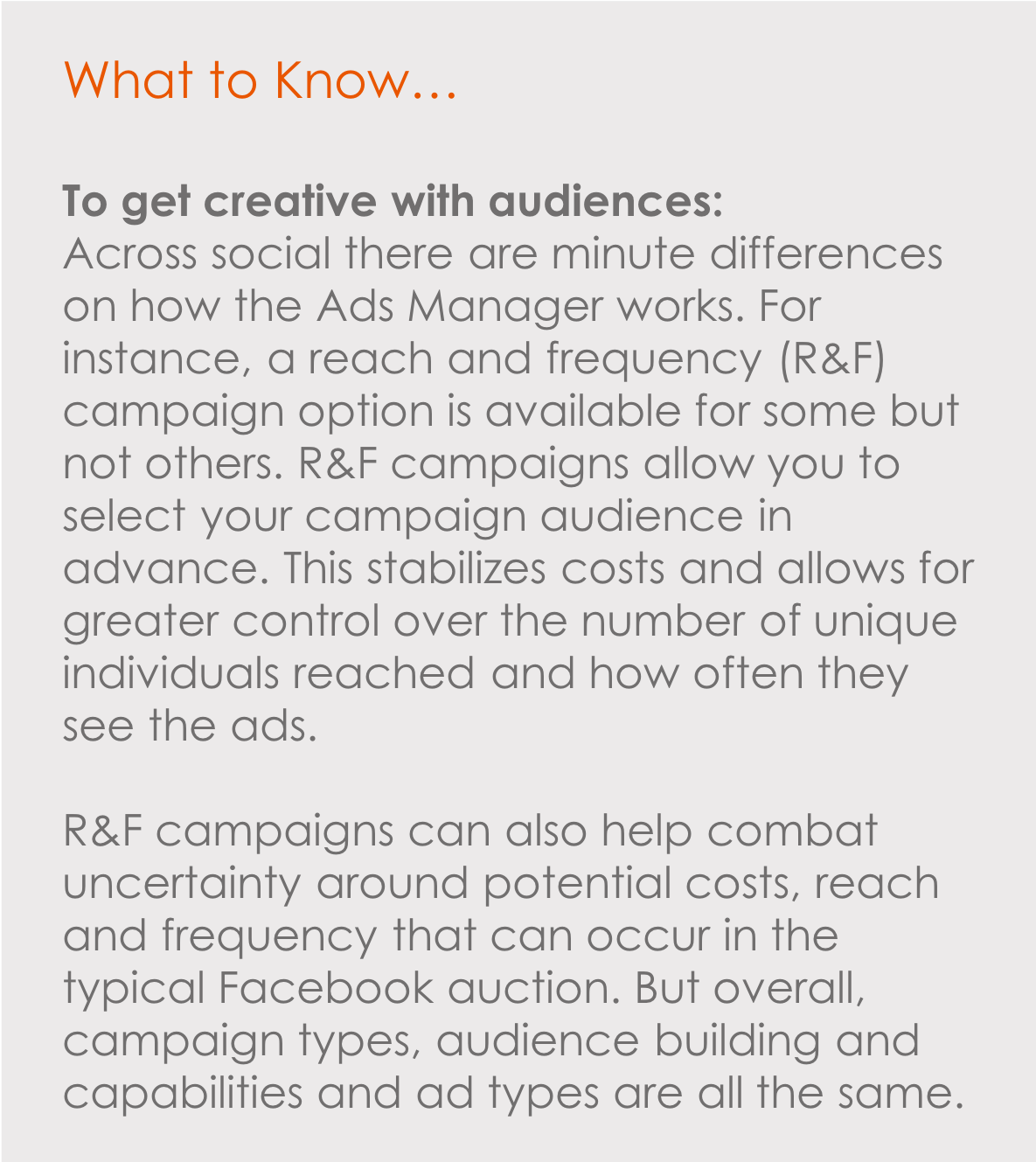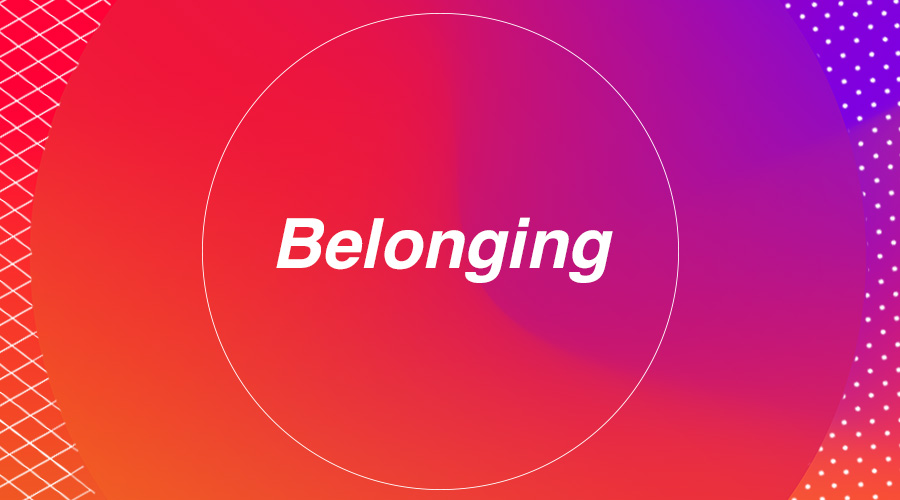The great thing about social media is that, for the most part, it’s a level playing field for advertising options. Sure, bigger companies most likely have bigger budgets, but when it comes down to actual ad types and specifications, everyone is working with the same tools. You have options for awareness campaigns (brand awareness or reach), consideration campaigns (traffic, engagement, video views, lead gen, etc.) and conversion campaigns (conversion goals, catalog sales, store visits).
Whether you are a corporation like Apple or a Mom ‘n Pop fruit stand, you basically have the same options when it comes to the campaigns you want to run. So how do you stand out and compete against bigger budgets, established brands, pages with more followers or big-time influencers?
Well, you get creative! Literally and figuratively.
Getting Creative with Creative
 Challenge yourself and/or your creative department. With the same real estate that everyone else has, how can you differentiate your product in the eyes of potential consumers? What can you do to cause that pattern interruption? How do you go about getting noticed or cause someone in your target audience to take a second look?
Challenge yourself and/or your creative department. With the same real estate that everyone else has, how can you differentiate your product in the eyes of potential consumers? What can you do to cause that pattern interruption? How do you go about getting noticed or cause someone in your target audience to take a second look?
A little over a year ago, I saw one of the most unique, creative posts on Facebook I’d ever seen. This video was an organic post released around Halloween, the background was a mock-up of Facebook’s timeline and as you scrolled through your feed, the video auto plays. It was difficult to tell (especially on mobile) that you are on the video and not just further down your feed. Almost immediately when the video starts, an extremely life-like spider begins to crawl up from the bottom over the newsfeed. The fact that Facebook’s background is well mimicked and a still frame, it leaves the viewer feeling like there is a spider on their phone! Because of social sharing, the video was viewed well over 30 million times. You can see the post here, (but for the best experience, view it on a mobile device.)
At Simantel, we wanted to find a way to utilize creativity similar to this for one of our clients to promote a new product launch. For paid ads, Facebook’s terms of service and advertising policies don’t allow you to mimic the timeline, so our creative team came up with a fantastic alternative. We built out what appeared to be a normal-looking single image post for the product launch. Instead of a spider scurrying across a timeline, we had a dozer plow through the traditional ad.

TIP: Challenge your team to find new ways to put twists on ad types. Find ways to leverage augmented reality (AR), 360 and 3D photos in organic posts. Keep an ear to the ground for the ability to use those capabilities in paid advertisements. A great example of 3D animation is this Jurassic Park-ish post.
Getting Creative with Audiences
 Figure out ways to understand your users’ behavior. The Facebook Pixel is a very important piece of code to add to your website. Functioning much like Google Analytics, the pixel monitors user behavior on your site and enables you to track specific conversions based on pre-determined goals. By installing code on your site, you can implement standard events such as view content, add to cart, purchase, etc. Facebook also allows you to create “custom conversions” which are URL-based activities (a URL containing “thankyou”, “checkout” , “formsubmit”, etc.) These events do not require any coding to setup.
Figure out ways to understand your users’ behavior. The Facebook Pixel is a very important piece of code to add to your website. Functioning much like Google Analytics, the pixel monitors user behavior on your site and enables you to track specific conversions based on pre-determined goals. By installing code on your site, you can implement standard events such as view content, add to cart, purchase, etc. Facebook also allows you to create “custom conversions” which are URL-based activities (a URL containing “thankyou”, “checkout” , “formsubmit”, etc.) These events do not require any coding to setup.
The benefits of these events and the pixel are:
- Tracking whether or not your campaign is meeting its objective.
- Building custom audiences based off of these events.
- Getting extremely creative with how you utilize these audiences.
In general, you can look at Facebook audiences in two ways; warm and cold. Cold audiences are the population who you are reaching for the first time or are basically unaware of or not too familiar with your offerings. Cold audiences typically require more handholding or encouragement to complete a desired action. You need to move them down the funnel from awareness, to consideration, to conversion. Warm audiences are those who have been introduced to your offerings previously and have interacted with you at some point. Usually these individuals are further down the funnel and require less effort to convert.
The point to remember about warm and cold audiences is that you will need different messages for both. Creating custom audiences based on engagement with your Facebook page, Facebook Ads and website allows you to segment which audiences see which messages. An individual who has visited your website multiple times in the past 30 days and has completed desired actions (i.e. purchase, download, enews signup, etc.) most likely doesn’t need to see an “introduction video” about your brand. So, when creating your “intro video” audience, you can exclude individuals who have previously visited and engaged with your website.
Running Facebook ads for ecommerce clients? Create ads specifically for individuals who have abandoned shopping carts. Using timeframes with custom audiences allows you to show different ads based on when an abandoned cart event happened. For example, in the first 24 hours after an abandoned cart occurs, you can deliver ads to these individuals offering a 10 percent discount. If there is no action, you then create an ad for abandoned carts offering a 20 percent discount for, say the next three days. You set your audiences up so that anyone falling in the first 24-hour window is excluded from the 20 percent offer. By using timeframes and exclusions, you can stair-step offers to people who left your site without completing the desired action.
Don’t let the vast number of opportunities on social dilute how you can stand out from the rest. Instead, dive in and figure what’s best for your brand while keeping your posts and offers fresh for consumers.





